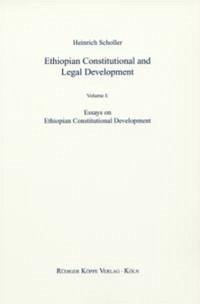
Ethiopian Constitutional and Legal Development
Vol. I: Essays on Ethiopian Constitutional Development
Versandkostenfrei!
Nicht lieferbar
In this publication the author wants to give an overview for the Ethiopian law student and the wider public on the modern law of their country. This access to modern law in Ethiopia should, however, not be separated from the historical legal tradition and legal culture of Ethiopia. During her history she has developed several remarkable codifications like the Ser'ata Mangest or the Feta Nagast, by which Ethiopia joined the family of Roman Law.In this first volume the focus is more on general aspects of the legal sources, comparative constitutional law, development of human rights in general an...
In this publication the author wants to give an overview for the Ethiopian law student and the wider public on the modern law of their country. This access to modern law in Ethiopia should, however, not be separated from the historical legal tradition and legal culture of Ethiopia. During her history she has developed several remarkable codifications like the Ser'ata Mangest or the Feta Nagast, by which Ethiopia joined the family of Roman Law.
In this first volume the focus is more on general aspects of the legal sources, comparative constitutional law, development of human rights in general and in Ethiopia as well as the development of constitutional review.
The author taught at the Law Faculty of the National University of Ethiopia from 1972 to 1975 and has visited the country regularly since then.
This volume consists of early publications and of papers either presented to workshops concerning Ethiopia, which were very often organised by the Friedrich-Ebert-Foundation during the years 1992 and 2002, or given during different conferences on Ethiopian law mainly at the International Conferences of Ethiopian Studies (ICES).
The representation of Ethiopian law is based on the comparative legal methods, especially by the use of Europen and American models. So, the near legalistic method is enriched by a comparative approach.
The forthcoming second volume will extend the presentation to legal history and legal sociology, so that it will be possible to use the two volumes not only for constitutional law but also for legal theory.
Mit der vorliegenden Publikation möchte der Autor sowohl äthiopischen Jurastudenten als auch dem breiten Publikum einen Überblick über das moderne Recht Äthiopiens geben. Dies muß mit dem Blick auf die historische Gesetzestradition und Gesetzeskultur Äthiopiens einhergehen. Im Laufe der Geschichte des Landes hat diese Tradition einige herausragende Kodifizierungen wie das Ser'ata Mangest und das Feta Nagast hervorgebracht, durch die Äthiopien in die Familie des Römischen Rechts beitrat.
In diesem ersten Band liegt der Fokus auf generellen Aspekten wie den Rechtsursprüngen, der komparativen konstitutionellen Gesetzgebung, der Entwicklung der Menschenrechte im allgemeinen und in Äthiopien einerseits und der Entwicklung des Verfassungsrechts andererseits.
Der Autor lehrte von 1972 bis 1975 an der Law Faculty der National University of Ethiopia und besuchte das Land seitdem regelmäßig.
Der vorliegende Band enthält frühe Publikationen des Autors und Vortragstexte, die einerseits in Workshops präsentiert wurden und die sehr häufig von der Friedrich-Ebert-Stiftung in den Jahren 1992 und 2002 organisiert wurden, oder andererseits während verschiedener Konferenzen zur Äthiopischen Gesetzgebung, vor allem während der International Conferences of Ethiopian Studies (ICES), gehalten wurden.
Die Repräsentation äthiopischer Gesetzgebung basiert auf vergleichenden Gesetzgebungsmethoden und hierbei vor allem auf europäischen und amerikanischen Vorbildern.
Der in Kürze erscheinende zweite Band wird die Präsentation des ersten Bandes um die Geschichte der Gesetzgebung und die Gesetzessoziologie bereichern. Beide Bände können so einen zusammenhängenden Einblick sowohl in die konstitutionelle Gesetzgebung als auch in die Gesetzestheorie geben.
In this first volume the focus is more on general aspects of the legal sources, comparative constitutional law, development of human rights in general and in Ethiopia as well as the development of constitutional review.
The author taught at the Law Faculty of the National University of Ethiopia from 1972 to 1975 and has visited the country regularly since then.
This volume consists of early publications and of papers either presented to workshops concerning Ethiopia, which were very often organised by the Friedrich-Ebert-Foundation during the years 1992 and 2002, or given during different conferences on Ethiopian law mainly at the International Conferences of Ethiopian Studies (ICES).
The representation of Ethiopian law is based on the comparative legal methods, especially by the use of Europen and American models. So, the near legalistic method is enriched by a comparative approach.
The forthcoming second volume will extend the presentation to legal history and legal sociology, so that it will be possible to use the two volumes not only for constitutional law but also for legal theory.
Mit der vorliegenden Publikation möchte der Autor sowohl äthiopischen Jurastudenten als auch dem breiten Publikum einen Überblick über das moderne Recht Äthiopiens geben. Dies muß mit dem Blick auf die historische Gesetzestradition und Gesetzeskultur Äthiopiens einhergehen. Im Laufe der Geschichte des Landes hat diese Tradition einige herausragende Kodifizierungen wie das Ser'ata Mangest und das Feta Nagast hervorgebracht, durch die Äthiopien in die Familie des Römischen Rechts beitrat.
In diesem ersten Band liegt der Fokus auf generellen Aspekten wie den Rechtsursprüngen, der komparativen konstitutionellen Gesetzgebung, der Entwicklung der Menschenrechte im allgemeinen und in Äthiopien einerseits und der Entwicklung des Verfassungsrechts andererseits.
Der Autor lehrte von 1972 bis 1975 an der Law Faculty der National University of Ethiopia und besuchte das Land seitdem regelmäßig.
Der vorliegende Band enthält frühe Publikationen des Autors und Vortragstexte, die einerseits in Workshops präsentiert wurden und die sehr häufig von der Friedrich-Ebert-Stiftung in den Jahren 1992 und 2002 organisiert wurden, oder andererseits während verschiedener Konferenzen zur Äthiopischen Gesetzgebung, vor allem während der International Conferences of Ethiopian Studies (ICES), gehalten wurden.
Die Repräsentation äthiopischer Gesetzgebung basiert auf vergleichenden Gesetzgebungsmethoden und hierbei vor allem auf europäischen und amerikanischen Vorbildern.
Der in Kürze erscheinende zweite Band wird die Präsentation des ersten Bandes um die Geschichte der Gesetzgebung und die Gesetzessoziologie bereichern. Beide Bände können so einen zusammenhängenden Einblick sowohl in die konstitutionelle Gesetzgebung als auch in die Gesetzestheorie geben.



